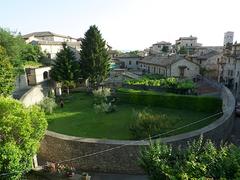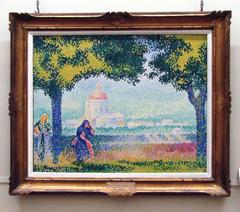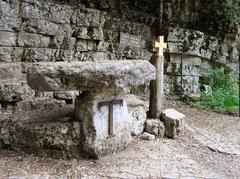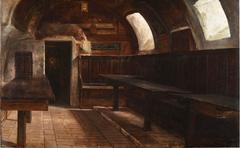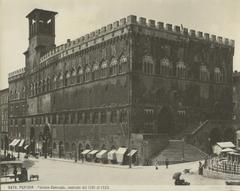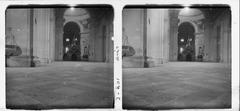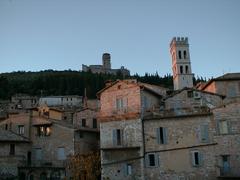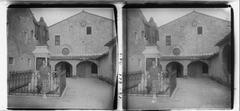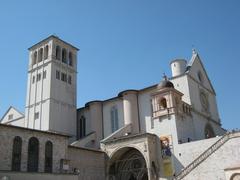Museo della Porziuncola Visiting Hours, Tickets, and Travel Guide: Assisi Historical Sites
Date: 14/06/2025
Introduction: The Heart of Franciscan Heritage
Nestled within the Basilica of Santa Maria degli Angeli in Assisi, the Museo della Porziuncola is a cornerstone of Christian history and art. It preserves the legacy of St. Francis of Assisi, who founded the Franciscan Order at the Porziuncola chapel in the early 13th century. Today, the museum offers a unique blend of spiritual, historical, and artistic experiences, attracting pilgrims, art lovers, and cultural explorers from around the world (porziuncola.org, Assisi OFM, whichmuseum.com).
Historical Overview
The Origins of the Porziuncola
The Porziuncola, meaning “little portion,” began as a humble chapel on the outskirts of Assisi. In 1208–1209, St. Francis restored it, making it the birthplace of the Franciscan Order. It was here that Francis received his first followers, composed the Rule, and experienced profound spiritual events. In 1216, Pope Honorius III granted the “Pardon of Assisi,” making the chapel a major pilgrimage destination (porziuncola.org).
The Basilica and Museum
With growing significance, the Basilica of Santa Maria degli Angeli was constructed (1569–1679) to encase and protect the Porziuncola chapel. The Museo della Porziuncola, established within the basilica complex, deepens visitors’ understanding of Franciscan history and preserves important artifacts, artworks, and manuscripts (Assisi OFM).
Museum Layout and Thematic Organization
The museum is housed in the original convent spaces, preceding the basilica. Its thematic journey spans six main rooms:
- Pre-Franciscan Porziuncola: Archaeological and documentary evidence of the site’s origins.
- Foundations of Franciscan Spirituality: Early community formation and values.
- Franciscan Observance Era: Reforms and the site’s evolving role.
- Marian Devotion: Artworks and liturgical items dedicated to the Virgin Mary.
- Alessian Basilica and 19th-Century Reconstruction: Architectural developments.
- The Medieval Conventino: Restored monastic cells illustrating daily life.
This structure allows visitors to trace the evolution of Franciscan spirituality, art, and architecture (Assisi OFM).
Artistic Heritage: Key Highlights
Masterpieces of Medieval and Renaissance Art
- Crocifisso di Giunta Pisano (1236): The earliest Italian “Crocifisso patiens,” pivotal in religious iconography.
- San Francesco e Angeli (Maestro di San Francesco, c. 1260): Iconic depiction of Francis among angels.
- Panel attributed to Cimabue (c. 1290): Early Renaissance style.
- Madonna del Latte (late 14th century): A polychrome stone Madonna and Child.
- Dossale in terracotta invetriata (Andrea della Robbia, c. 1475): A glazed terracotta altarpiece.
Liturgical and Decorative Arts
- Renaissance cope (late 16th century): Embroidered with Marian themes.
- Altar Frontal (17th century): Illustrating the Pardon of Assisi.
- Historical reconstructions: Including the altar as it appeared up to the 20th century.
The Conventino: A Glimpse of Monastic Life
The restored Conventino preserves 17 monastic cells and communal spaces, offering a tangible connection to the lifestyle of early Franciscan friars. It also hosts rotating exhibitions of sacred art (Assisi OFM).
Visitor Information: Hours, Tickets, and Accessibility
- Visiting Hours: Typically open Tuesday to Sunday, 9:00 AM – 6:00 PM (last entry 5:30 PM); closed Mondays and select religious holidays. Hours may vary—verify on the official website.
- Ticket Prices: Standard adult ticket €6; reduced rates for EU citizens aged 18–25 (€3); free for children under 18 and Assisi residents.
- Guided Tours: Available daily in multiple languages; pre-booking recommended during high season.
- Accessibility: The museum is partially wheelchair accessible—contact ahead for assistance. Braille guides and tactile exhibits support visually impaired visitors; sign language tours available upon request.
- Photography: Allowed without flash or tripods. Early mornings and late afternoons offer the best conditions.
Educational Programs and Guided Tours
The museum offers daily guided tours (approx. 60 minutes) in several languages, customizable for interests in art, theology, or medieval history. School groups benefit from curriculum-aligned workshops emphasizing Franciscan values. Special lectures, temporary exhibitions, and concerts are scheduled regularly (Assisi OFM).
Special Events and Living Traditions
Major events such as the “Pardon of Assisi” (August 1–2) and the “Feast of Our Lady of the Angels” (August 15) attract thousands of pilgrims. Festivals feature processions, liturgies, music, and thematic museum exhibitions, enriching the spiritual and cultural ambiance (porziuncola.org).
Community Engagement and Inclusivity
The museum collaborates with local schools, universities, and cultural organizations, promoting Franciscan heritage and contemporary artistic dialogue. Inclusivity initiatives include discounted/free admission for various groups and multilingual interpretive materials (whichmuseum.com).
Travel Tips
- Getting There: Located about 4 km from central Assisi, accessible by local bus, taxi, or on foot.
- Dress Modestly: Due to the religious nature of the site.
- Plan Ahead: Book tickets and tours in advance during peak seasons.
Visitor Services and Amenities
- Multilingual Staff: Available for assistance.
- Gift Shop: Books, religious items, and crafts, with proceeds supporting the museum.
- Café: Serving local specialties.
- Rest Areas: Benches and quiet corners throughout the museum.
Virtual Tours and Online Resources
For those unable to visit in person, the museum offers virtual tours and high-quality images of its collections on the official website. Alt tags are optimized for search terms like “Museo della Porziuncola sacred art” and “Franciscan museum Assisi” (porziuncola.org).
Frequently Asked Questions (FAQ)
Q: What are the Museo della Porziuncola’s visiting hours?
A: Tuesday to Sunday, 9:00 AM – 6:00 PM; closed Mondays and religious holidays.
Q: How much are tickets?
A: Standard adult €6; discounts for youth and locals; free for children under 18.
Q: Is the museum accessible?
A: Partially; contact ahead for wheelchair access and other needs.
Q: Are guided tours available?
A: Yes, in multiple languages—book in advance.
Q: Can I take photos?
A: Yes, without flash or tripods in most areas.
Q: How long does a visit take?
A: 1–2 hours on average; art enthusiasts may stay longer.
Conclusion: Plan Your Visit
The Museo della Porziuncola is a unique destination where history, art, and spirituality converge. With well-curated collections, inclusive services, and a serene environment, it offers an enriching experience for all visitors. Whether you are drawn by faith, art, or curiosity, the museum invites you to discover the enduring legacy of the Franciscan movement in the heart of Assisi.
For the latest information on hours, tickets, and events, visit the official Museo della Porziuncola website and Assisi OFM. You can enhance your visit with the Audiala app for audio guides and stay updated via social media channels.
